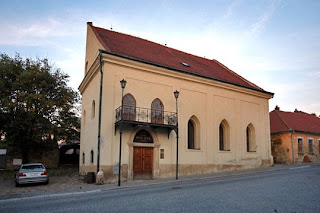At a sidewalk café in Vienna my wife, Ronnie, and I gorged
on obscenely delicious pastries. Embarrassingly, unable to make a choice from
the broad selection, we had ordered one of each. Our tourist guide book lay on the table among
the remnants of our unforgettable indiscretion. Sticky with icing, cream and meringue
my index finger rested on a photo of an incredibly ornate building interior
with walls lavishly decorated with Hebrew script and colorful designs. “What’s this?” I asked Ronnie. Studying the guide
book she replied that it was the synagogue in a town named Boskovice in the
Czech Republic only a day’s drive away. With extensive Hebrew writing and
detailed painted designs on the walls and ceiling, the little synagogue was not
just unique, it was absolutely gorgeous. Having never before seen a synagogue
that was even remotely similar we resolved to drive to Boskovice the very next
day.
 |
| Boskovice Synagogue |
 |
| Hebrew Script Ceiling of Synagogue Hallway |
Boskovice is a small market town near Brno in southern
Moravia. The synagogue sits among the narrow lanes of the section that was once
the Jewish ghetto. Following the Holocaust there were only 12 Jewish residents
in Boskovice, the last dying in 1996. The building is now owned by the Jewish
Community of Brno which maintains it as a Jewish museum and venue for art exhibitions,
concerts and cultural events. The gracious, English speaking, museum-synagogue
director, Ondrej told us a good bit about the synagogue and Boskovice’s Jewish
history. Originally opened in the mid-sixteen hundreds the building has been
renovated multiple times over the centuries. By the 19th century the
ghetto had an estimated 2,000 inhabitants and the synagogue grew to become a
center for Talmudic study. The Hebrew text embellishing the arches, vaults and
fluted columns are passages from the Torah, prayers and names of congregants,
while the curling floral motifs and architectural details are typical of
Moravia.
 |
| Boskovice Synagogue Sanctuary |
After a spellbinding hour with Ondrej, it was late in the
day. He accompanied us to a picturesque inn about 7 kilometers away. This storybook-perfect
inn was a series of interconnected cottages surrounding a courtyard, all in a
leafy forest with our room adjacent to a brook. True to our vision of a
Moravian country inn, there was a charming dining room complete with a huge
roaring fireplace where we and our new friend enjoyed a memorable evening and a
bottle of Moravia’s finest wine.
At the synagogue the next morning we met Ondrej for an
escorted walk around Boskovice’s once-upon-a-time ghetto quarter. As we walked
through an old arched gateway he said, “This gate and the wall defined the
Jewish ghetto. However as relations were good between the Christians and Jews, they
both went back and forth. In fact, in many places there was no wall -- the Christian
houses simply backed up to the Jewish houses.” Our tour complete, Ondrej
concluded, “If you liked Boskovice, you simply must see the synagogues in
Třebič and Holesove.”
Arriving in Třebič we found a bustling community centered
about an oblong town garden-piazza. We set out on foot to find the tourist
information bureau, intending to get directions to the synagogue. In front of
us, we saw a sign pointing to “Jew Town”.
Following the sign, we headed through a dark passage between two buildings
and over a pedestrian bridge crossing the bucolic Jihlava River to a hill
covered with old masonry and stucco buildings. This hill with its curvy
cobblestoned lanes, too-cute-to-be-true picturesque buildings and all of the
charm of a Breughel painting was once the old Jewish quarter.
 |
| Třebič Synagogue |
The Synagogue, dating from 1669, sits in the center of Jew
Town only a short walk up the hill from the bridge. Although there are no
longer any Jews living in Třebič, the city has restored the Synagogue, keeping
it open as a Jewish museum and exhibition-event venue. There we met a charming
young lady with impeccable English skills who, for the paltry price of 2 Euros admission,
escorted us through the museum in the second floor women’s gallery and around
the old ghetto. She explained that by the 17th century 60% of Třebič’s
population was Jewish and the town was the center of Moravian Jewish culture.
In 1848 emancipation laws freed Jews to live wherever the wished. Consequently,
during the following half-century Třebič’s Jewish community declined to a couple
hundred as most Jews migrated to larger cities. The handful of Jews who
returned from the Holocaust had dwindled away by 1952 when the area became a
UNESCO World Heritage Site.
 |
| Elaborately Painted Sanctuary of Třebič Synagogue |
Like the synagogue in Boskovice, the Třebič Synagogue’s
walls are decorated with Hebrew text, yet the fresco wall paintings are much
freer, less repetitive and geometric. Our guide explained that although she was
not Jewish she was studying Hebrew with a goal of conversion to Judaism. She
said her fiancé also plans to convert. They are purchasing one of the
incredibly cute old houses in Jew Town where they will live after their
marriage next year.
We visited six historic painted synagogues in the villages
of the Czech Republic. Each signficantly different from the others, each with
its own stories, each are irreplaceable relics of the area’s Jewish past. They
are highly accessible from Prague where you can visit the Jewish Museum of
Prague, one of the World’s most extensive collections of Judaic art, as well as
four incredible synagogues. Tours and guides are
available to take you to these treasures or you can do as we did: simply rent a
car with a GPS and head out for a memorable Jewish vacation. The entire country
is only half the size of Indiana so it’s easy going. Better yet, these are
painted ladies that your wife can visit with you!